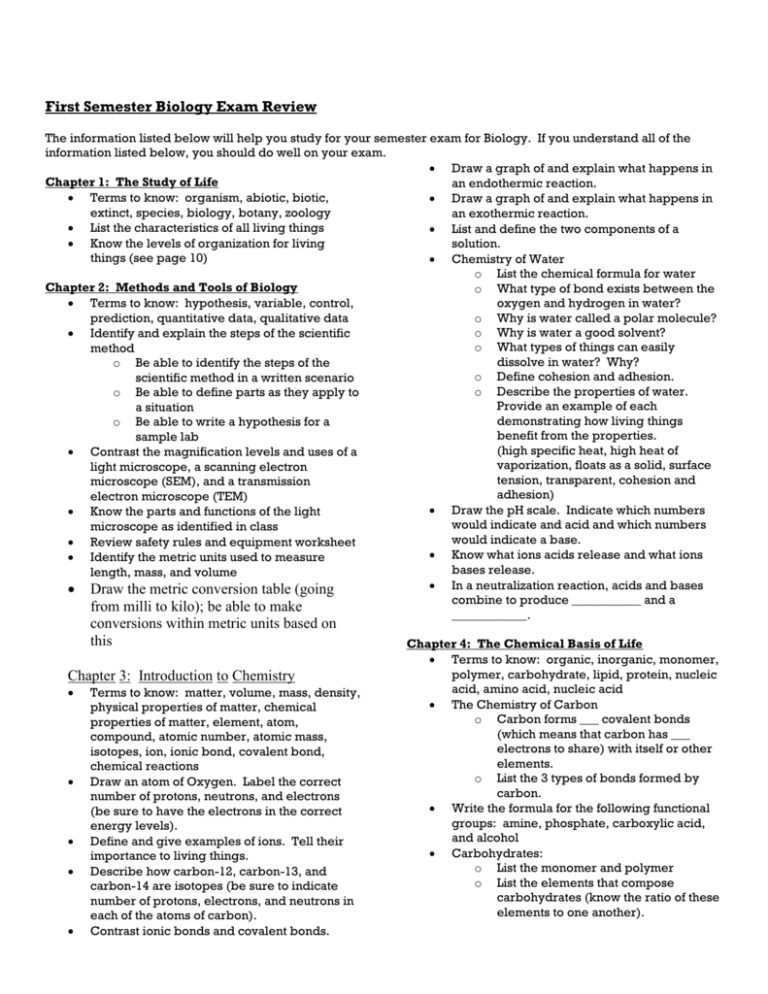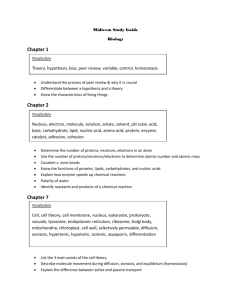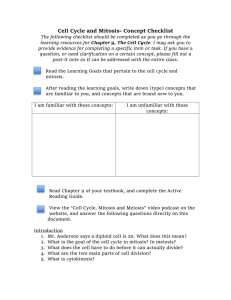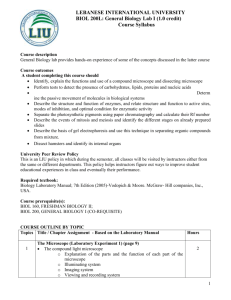Biology I
advertisement

First Semester Biology Exam Review The information listed below will help you study for your semester exam for Biology. If you understand all of the information listed below, you should do well on your exam. Draw a graph of and explain what happens in Chapter 1: The Study of Life an endothermic reaction. Terms to know: organism, abiotic, biotic, Draw a graph of and explain what happens in extinct, species, biology, botany, zoology an exothermic reaction. List the characteristics of all living things List and define the two components of a solution. Know the levels of organization for living things (see page 10) Chemistry of Water o List the chemical formula for water Chapter 2: Methods and Tools of Biology o What type of bond exists between the Terms to know: hypothesis, variable, control, oxygen and hydrogen in water? prediction, quantitative data, qualitative data o Why is water called a polar molecule? o Why is water a good solvent? Identify and explain the steps of the scientific o What types of things can easily method dissolve in water? Why? o Be able to identify the steps of the o Define cohesion and adhesion. scientific method in a written scenario o Describe the properties of water. o Be able to define parts as they apply to Provide an example of each a situation demonstrating how living things o Be able to write a hypothesis for a benefit from the properties. sample lab (high specific heat, high heat of Contrast the magnification levels and uses of a vaporization, floats as a solid, surface light microscope, a scanning electron tension, transparent, cohesion and microscope (SEM), and a transmission adhesion) electron microscope (TEM) Draw the pH scale. Indicate which numbers Know the parts and functions of the light would indicate and acid and which numbers microscope as identified in class would indicate a base. Review safety rules and equipment worksheet Know what ions acids release and what ions Identify the metric units used to measure bases release. length, mass, and volume In a neutralization reaction, acids and bases Draw the metric conversion table (going combine to produce ___________ and a from milli to kilo); be able to make ____________. conversions within metric units based on this Chapter 3: Introduction to Chemistry Terms to know: matter, volume, mass, density, physical properties of matter, chemical properties of matter, element, atom, compound, atomic number, atomic mass, isotopes, ion, ionic bond, covalent bond, chemical reactions Draw an atom of Oxygen. Label the correct number of protons, neutrons, and electrons (be sure to have the electrons in the correct energy levels). Define and give examples of ions. Tell their importance to living things. Describe how carbon-12, carbon-13, and carbon-14 are isotopes (be sure to indicate number of protons, electrons, and neutrons in each of the atoms of carbon). Contrast ionic bonds and covalent bonds. Chapter 4: The Chemical Basis of Life Terms to know: organic, inorganic, monomer, polymer, carbohydrate, lipid, protein, nucleic acid, amino acid, nucleic acid The Chemistry of Carbon o Carbon forms ___ covalent bonds (which means that carbon has ___ electrons to share) with itself or other elements. o List the 3 types of bonds formed by carbon. Write the formula for the following functional groups: amine, phosphate, carboxylic acid, and alcohol Carbohydrates: o List the monomer and polymer o List the elements that compose carbohydrates (know the ratio of these elements to one another). o o o o o o List examples of foods that are carbohydrates. Contrast monosaccharides, disaccharides, and polysaccharides. Contrast starch, glycogen, cellulose, and chitin. Which polysaccharides are for storage and which are for structure? Why is glucose the most important carbohydrate? Which carbohydrate is called “table sugar?” Lipids: o o o o List the monomer and polymer. List the elements that compose lipids. List examples of foods that are lipids. Contrast saturated fats, unsaturated fats, and polyunsaturated fats. Which one is best for you? o Contrast animal fats and plant oils (include state of matter at room temperature and type of fat: saturated or unsaturated). o Describe lipids as: insulators, waterproofers, important components of the cell membrane Proteins: o List the monomer and polymer. o List the elements that compose proteins. o List examples of foods that are proteins. o Name the special type of covalent bond found only in proteins. o List the 7 functions of proteins. o What is an enzyme? o Draw an example of how an enzyme works in a chemical reaction. o Discuss the importance of the active site. o Describe the “induced fit” hypothesis. Nucleic Acids: o List the monomer and polymer. o List the elements that compose nucleic acids. o List 2 examples of nucleic acids. o Contrast the types of sugars in DNA and RNA. o List the 4 nitrogen bases in DNA. o List the 4 nitrogen bases in RNA. o What is the name of the shape of DNA? Chapter 5: The Structure and Function of Cells Terms to know: organelle, fluid mosaic model, chromosomes, diffusion, osmosis, semipermeable membrane, concentration gradient Know the 3 parts to the cell theory. Know the contributions of the following people: Galileo, Leeuwenhoek, Hooke, Brown, Schwann, Schleiden, Virchow, Pasteur, Redi Contrast prokaryote and eukaryote. What type of organisms would be prokaryotic and what type would be eukaryotic? Draw an animal cell and a plant cell. In each cell, identify the following organelles as needed: cell membrane, cell wall, nucleus, chromosomes, cytoplasm, ribosome, rough endoplasmic reticulum, smooth endoplasmic reticulum, golgi bodies, mitochondria, lysosomes, vacuoles, and chloroplasts. Draw a phospholipid bilayer (cell membrane). Identify the hydrophobic tails, hydrophilic heads, and proteins. What is the name given to this model of the cell membrane? Draw a cell containing 70% water in each of the following types of solutions: hypertonic, hypotonic, and isotonic. Tell what would happen to the cell in each type of solution. Describe facilitated diffusion. How is active different from passive transport? Contrast endocytosis and exocytosis. Contrast pinocytosis and phagocytosis. Chapter 7: Cellular Reproduction Terms to know: interphase, mitosis, replication, sister chromatids, cytokinesis, cleavage furrow, cell plate formation, meiosis, gametes, diploid, haploid, fertilization, zygote, homologous pairs, crossing over Make a table describing each stage of mitosis and include a drawing of each stage in your table. Make a table describing each stage of meiosis and include a drawing of each stage in your table. Draw the cell cycle and describe the processes occurring in each. Where in an onion root tip does mitosis occur? Draw an onion root tip and label its regions. Tell how mitosis and meiosis differ. What cells undergo mitosis? What cells undergo meiosis? Draw the stages of mitosis and tell what occurs during each stage. Draw the stages of meiosis (I and II) and tell what occurs in each stage. When does crossing over occur? Why is it important? Define gametogenesis. How do spermatogenesis and oogenesis differ? Where do each occur? What do each produce? Define haploid and diploid. Give an example of cells for each. Define homologous chromosomes. What is the end result of meiosis? Describe fertilization of an egg cell by a sperm cell. Photosynthesis and Respiration Write the equation for both of these processes. How do the two processes relate to each other? Where do both take place? Tell the importance of chlorophyll in photosynthesis. How do breathing and cellular respiration differ? List the steps involved in the production of ATP from a molecule of glucose.








